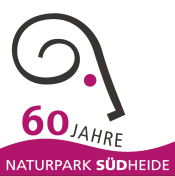
Evolution of nature and landscape in the Südheide nature park
The soils and the relief in the Südheide nature park originated in the Ice Age. During the second last Ice Age (Saale Ice Age), which ended about 130,000 years ago and lasted some 170.000 years, the area of today’s nature park was covered by enormous masses of ice, glaciers. During the interglacial warm periods the glaciers melted and retreated, leaving behind sand, debris and scree masses as ground, lateral and terminal moraines. Before the enormous glaciers thick sand deposits, so-called outwash plains, formed due to material sorting caused by the flowing water and became the starting material for today’s sandy heath soils. Only undemanding, natural forest communities of birches, common oaks, pines and beeches grew on these nutrient-poor soils. The heaths came into being as a result of overexploitation in medieval times due to grazing, tree felling and the removal of litter and topsoil. After the afforestation at the end of the 1800s today’s pine forests came into being.
With the retreat of the glaciers numerous melting water streams formed and combined to create glacial valleys. For example, the glacial valley of the Aller and the Örtze with its typical lateral and basin moors came into existence.
During one of these warm periods, the kieselgur reservoirs near Oberohe were formed from the deposited shells of dead diatoms.











